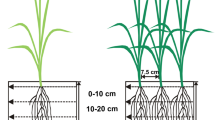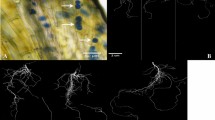Abstract
The activity of soil pathogens, competition for assimilates, and the changing availability of below-ground resources make root systems subject to a continuous and dynamic process of formation and loss of both fine and coarse roots. As hypocotyl borne roots appear later than other root classes, they may serve to functionally replace basal and primary roots lost to biotic and abiotic stress. Using common bean (Phaseolus vulgaris L.), we conducted experiments in solution and solid media culture with treatments involving the removal of part of the root system (basal, hypocotyl borne or primary roots), phosphorus availability, and depth of seeding to test the hypothesis that there are compensation mechanisms among basal, hypocotyl borne and primary roots to cope with the loss of part of the root system. The root system was highly plastic in response to root excision, which resulted in the maintenance of below-ground biomass accumulation. In most cases, this compensation among root classes was enough to maintain plant performance in both phosphorus sufficient and phosphorus stressed plants. Removal of a specific root class induced an increase in the growth of the remaining root classes. All root classes, but especially the primary root, contributed to the compensation mechanism in some way. Primary roots represented around 10% of the root system in control plants and this proportion increased dramatically (up to 50%) when other root classes were removed. In contrast, negligible compensatory re-growth was observed following removal of the primary root. Greater planting depth increased the production of hypocotyl borne roots at the expense of basal roots. The proportion of hypocotyl borne roots increased from 25% of the whole root system when seeds were placed at a depth of 2 cm to 30% when they were placed at 5 cm and to 38% when placed at 8 cm, with corresponding decreases in the proportion represented by basal roots. The common feature of our observations is the innate ability of the root system for its own regeneration. Total root biomass maintained strict allometric relationships with total shoot biomass in all treatments. Re-stabilization of root to shoot balance after partial root loss is governed by overall plant size following allometric relationships similar to undisturbed plants. However, the pattern of this root regeneration was not uniform since the way the three root classes compensated each other after the removal of any one of them varied among the different growth media and phosphorus supply conditions. The resulting changes in root architecture could have functional significance for soil resource acquisition.







Similar content being viewed by others
References
Barber S (1995) Soil nutrient bioavailability: A mechanistic approach. J Wiley and Sons, New York, p 414
Bonser AM, Lynch JP, Snapp S (1996) Effect of phosphorus deficiency on growth angle of basal roots of Phaseolus vulgaris L. New Phytol 132:281–288
Edwards JH, Barber SA (1976) Phosphorus uptake rate of soybean roots as influenced by plant age, root trimming, and solution P concentration. Agron J 68:973–975
Eissenstat DM (1997) Trade-offs in root form and function. In: Jackson LE (ed) Ecology in Agriculture. Academic Press, San Diego, pp 173–199
Eissenstat DM, Yanai RD (2002) Root Lifespan, efficiency, and turnover. In: Waisel Y, Eshel A, Kafkafi U (eds) Plant Roots: The Hidden Half. Marcel Dekker Inc., New York, pp 221–238
Ge Z, Rubio G, Lynch JP (2000) The importance of root gravitropism for interroot competition and phosphorus acquisition efficiency: results from a geometric simulation model. Plant Soil 21:159–171
Gray M, Steffey KL (1998) Corn rootworm (Coleoptera: Chrysomelidae) larval injury and root compensation of 12 maize hybrids: an assessment of the economic injury index. J Econ Entom 91:723–740
Fisher MCT, Eissenstat DM, Lynch JP (2002) Lack of evidence for programmed root senescence in common bean (Phaseolus vulgaris) grown at different levels of phosphorus supply. New Phytol 153:63–71
Fitter A (1991) The ecological significance of root system architecture. In: Atkinson D (ed) Plant root growth. An ecological perspective. Blackwell Scientific Publications, Oxford, pp 229–246
Ho MD, Rosas JC, Brown KM, Lynch JP (2005) Root architectural tradeoffs for water and phosphorus acquisition. Funct Plant Biol 32:737–748
Hunt R (1990) Basic growth analysis. London, Unwin Hyman Ltd
Jungk A, Barber SA (1975) Plant age and the phosphorus uptake characteristics of trimmed and untrimmed corn root system. Plant Soil 42:227–239
Liao H, Rubio G, Yan X, Cao A, Brown KM, Lynch JP (2001) Effect of phosphorus availability on basal root shallowness in common bean. Plant Soil 232:69–79
Liao H, Yan X, Rubio G, Beebe SE, Blair MW, Lynch JP (2004) Genetic mapping of basal root gravitropism and phosphorus acquisition efficiency in common bean. Funct Plant Biology 31:959–970
Lynch JP Roots of the second green revolution. Aust J Bot (in press)
Lynch JP (1995) Root architecture and plant productivity. Plant Physiol 95:7–13
Lynch JP (2005) Root architecture and nutrient acquisition. In: Bassirirad H (ed) Nutrient acquisition by plants: an ecological perspective, Ecological Studies Volume 181. Springer-Verlag, Berlin, FRG, pp 147–183
Lynch JP, Brown KM (2001) Topsoil foraging – an architectural adaptation of plants to low phosphorus availability. Plant Soil 237:225–237
Lynch JP, Brown KM (2006) Whole plant adaptations to low phosphorus availability. In: Huang B (ed) Plant-Environment Interactions. Taylor and Francis, New York, pp 209–242
Lynch JP, van Beem J (1993) Growth and architecture of seedling roots of common bean genotypes. Crop Sci 33:1253–1257
Lynch JP, Epstein E, Lauchli A, Weigt GI (1990) An automated greenhouse sand culture system suitable for studies of P nutrition. Plant Cell Environ 13:547–554
Lynch JP, Ho MD (2005) Rhizoeconomics: carbon costs of phosphorus acquisition. Plant Soil 269:45–56
Miller CR, Ochoa I, Nielsen KL, Beck D, Lynch JP (2003) Genetic variation for adventitious rooting in response to low phosphorus availability: potential utility for phosphorus acquisition from stratified soils. Funct Plant Biol 30:973–985
Murphy J, Riley JP (1962) A modified single solution method for the determination of phosphate in natural waters. Anal Chim Acta 27:31–46
Nielsen KL, Eshel A, Lynch JP (2001) The effect of phosphorus availability on the carbon economy of contrasting common bean genotypes (Phaseolus vulgaris L.) genotypes. J Exp Bot 52:329–339
Niklas K (2006) Plant allometry, leaf nitrogen and phosphorus stoichiometry, and interspecific trends in annual growth rates. Ann Bot 97:155–163
Ochoa IE, Blair MW, Lynch JP (2006) QTL Analysis of adventitious root formation in common bean (Phaseolus vulgaris L.) under contrasting phosphorus availability. Crop Sci 46:1609–1621
Paolillo DJ Jr, Zobel R (2002) The formation of adventitious roots on root axes is a widespread occurrence in field-grown dicotyledonous plants. Am J Bot 89:1361–1372
Passioura JB (2002) Soil conditions and plant growth. Plant Cell Env 25:311–318
Pothuluri JV, Kissel DE, Whitney DA, Thien SJ (1986) Phosphorus uptake from soil layers having different soil test phosphorus levels. Agron J 78:991–994
Matamala R, Gonzàlez-Meler MA, Jastrow JD, Norby RJ, Schlesinger WH (2003) Impacts of Fine Root Turnover on Forest NPP and Soil C Sequestration Potential. Science 302:1385–1387
Riedell W, Evenson D (1993) Rootworm feeding tolerance in single cross maize hybrids from different eras. Crop Sci 33:951–955
Rogers R, Owens JC, Tollefson J, Witkowski JF (1975) Evaluation of commercial corn hybrids for tolerance to corn rootworms. Environ Entom 4:920–922
Rubio G, Walk T, Ge Z, Yan X, Liao H, Lynch JP (2001) Root gravitropism and belowground competition among neighboring plants: a modeling approach. Ann Bot 88:929–940
Rubio G, Liao H, Yan X, Lynch JP (2003) Topsoil foraging and its role in plant competitiveness for phosphorus in common bean. Crop Sci 43:598–607
Singh S, Gepts P, Debouck DG (1991) Races of common bean (Phaseolus vulgaris, Fabacea). Econ Bot 45:379–396
Thaler P, Pages LC (1999) Why are laterals less affected than main axes by homogeneous unfavourable physical conditions? A model-based hypothesis. Plant Soil 217:151–157
Walk T, Jaramillo R, Lynch JP (2005) Architectural tradeoffs between adventitious and basal roots for phosphorus acquisition. Plant Soil 279:347–366
Wijesinghe D, John EA, Beurskens S, Hutchings MJ (2001) Root system size and precision in nutrient foraging: responses to spatial pattern of nutrient supply in six herbaceous species. J Ecol 89:972–983
Zhu J, Kaeppler SM, Lynch JP (2005a) Topsoil foraging and phosphorus acquisition efficiency in maize (Zea mays L.). Funct Plant Biol 32:749–762
Zhu J, Kaeppler SM, Lynch JP (2005b) Mapping of QTL for lateral root branching and length in maize (Zea mays L.) under differential phosphorus supply. Theor Appl Genet 111:688–695
Zobel R (1996) Genetic control of root systems. In: Waisel Y, Eshel A, Kafkafi U (eds) Plant Roots: The Hidden Half. Marcel Dekker Inc., New York, pp 21–30
Acknowledgements
Thanks to Kathleen Brown for reading and improving the manuscript. GR is a member of the Scientific Science Council of Argentina (CONICET). Support was provided by NSF grant no. 0135872 to JPL and Kathleen Brown and Bean/Cowpea CRSP funding to JPL.
Author information
Authors and Affiliations
Corresponding author
Rights and permissions
About this article
Cite this article
Rubio, G., Lynch, J.P. Compensation among root classes in Phaseolus vulgaris L.. Plant Soil 290, 307–321 (2007). https://doi.org/10.1007/s11104-006-9163-7
Received:
Accepted:
Published:
Issue Date:
DOI: https://doi.org/10.1007/s11104-006-9163-7




